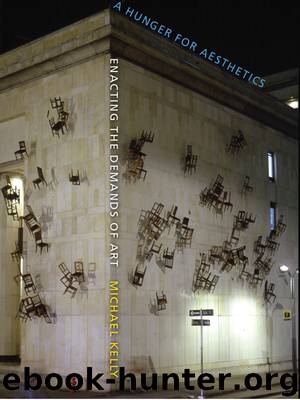A Hunger for Aesthetics by Kelly Michael;

Author:Kelly, Michael;
Language: eng
Format: epub
Tags: PHI001000, Philosophy/Aesthetics, ART015000, Art/History/General
Publisher: Columbia University Press
Published: 2012-05-21T16:00:00+00:00
FIGURE 3.7
Gerhard Richter, War Cut (2004), p. 326. (Reproduced with permission of the artist and Marian Goodman Gallery, New York)
At the same time, the close-ups of Richter’s painting were surrogates for the images of the war that were withheld or else closely censored by the U.S. government, which exercised unprecedented iconoclastic control over the production and dissemination of war images to prevent them from having moral-political effects on the public(s) that they would not be able to control. That is, the government was worried that if the American public saw images of American or Iraqi casualties (other than Saddam), their support of the invasion might be weakened or they might become skeptical of their largely uncritical acceptance of the official rationale for the invasion. Visible only through controlled images, the war was thus mainly an abstraction to the general public. Against this background, some of Richter’s close-ups look like blurred television or video screens (especially the ones with vertical stripes/striations), others have a deceptively pastoral (or Monet-like) effect, and those that are red look destructive. Individually and collectively, however, the close-ups are blurry, just as the war at the time was a visual blur, an abstraction, a mostly invisible event except for the television and newspapers images “brought to you by” the embedded journalists, the U.S. government–authorized text and image makers. In this light, Richter’s War Cut enacts the iconoclastic use and abuse of war images while sustaining a place for images that would enact a more complete picture of the war, allowing it to come into view, as has increasingly happened (the Abu Ghraib images are the most infamous, but there was also an “iconoclash” over whether military photographs of American soldiers returning home in flag-draped coffins should be seen by the general public). It is not that Richter chose to publish abstract images instead of more realistic images. He had no choice, because there were no “real” images available in March 2003 (figure 3.8).
What can artists possibly do when they are in such a situation? What representational substance can their art possibly have when the state controls the imagery that would allow us to see the war and thereby be better able to critique it? Does Richter’s War Cut merely enact the absence of any representational substance in art in the face of the Iraq War, as many of his anti-aesthetic interpreters would likely argue, given what they have said of his other work, even the Baader-Meinhof series? On the contrary, War Cut achieves much more. It enacts perhaps all the representational substance that existed in late March 2003, given that the U.S. government effectively controlled the war images. Richter enacts this control by reproducing abstract close-ups that were in turn mediated by newspaper texts that were themselves mediated because information about the war was also heavily controlled and Richter produced mostly excerpts. He enacts this predicament of control (i.e., iconoclasm) very well by engaging in art. At the same time, he enacts the fact that something was
Download
This site does not store any files on its server. We only index and link to content provided by other sites. Please contact the content providers to delete copyright contents if any and email us, we'll remove relevant links or contents immediately.
Ancient Worlds by Michael Scott(2625)
Savage Harvest by Carl Hoffman(1913)
The Monuments Men by Robert M. Edsel(1740)
Cain by Jose Saramago(1495)
The Apogee - Byzantium 02 by John Julius Norwich(1411)
A History of the World in 100 Objects by MacGregor Neil(1312)
The O. Henry Prize Stories 2014 by Laura Furman(1209)
The Unfinished Palazzo by Judith Mackrell(1142)
The Swerve by Greenblatt Stephen(1122)
The Lost Secrets of Maya Technology by James A. O'Kon(1091)
50 Art Ideas You Really Need to Know by Susie Hodge(1053)
Joan Miró by Joan Miró(1033)
4 3 2 1 by Paul Auster(1023)
Cain by Saramago José(1016)
A Piece of the World by Christina Baker Kline(995)
Heretics and Heroes by Thomas Cahill(987)
The Book of Ruby(968)
Raising Hell: A Concise History of the Black Arts and Those Who Dared to Practice Them by Robert Masello(952)
1484244826 by Unknown(902)
